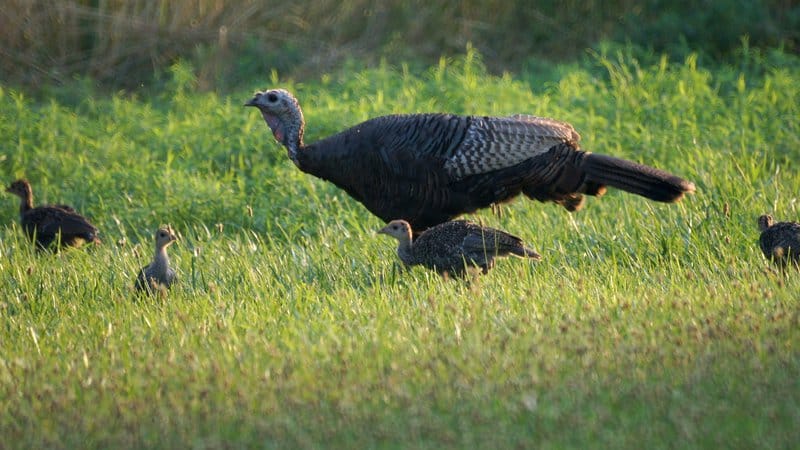Report your local turkey hatch to the AGFC
ON 06-08-2022

June 8, 2022
Randy Zellers
Assistant Chief of Communications
LITTLE ROCK — It’s been one month since turkey hunters hung up the slate-and-peg or trusty box call in pursuit of one of the most addicting game species Arkansas has to offer, but that doesn’t mean it’s time out for turkeys at the Arkansas Game and Fish Commission. In fact, now is the perfect time to help biologists with the AGFC keep tabs on this year’s reproduction by participating in the annual Wild Turkey and Northern Bobwhite Population Survey.
These surveys have been conducted each spring for more than 30 years to monitor reproduction and population trends in Arkansas’s wild turkeys and quail. Both species have relatively short lifespans, which makes annual reproduction extremely important to the total population and the quality of hunting in the short- and long-term.
Traditionally, these surveys were carried out by AGFC staff and volunteers from partner organizations such as the U.S. Forest Service, the U.S. Fish and Wildlife Service and county extension offices. However, thanks to the increased ability to communicate with members of the general public about aging poults and the increased enthusiasm of citizen-science projects, the AGFC has opened the surveys to any conservation-minded hunter or outdoorsperson willing to help keep tabs on Arkansas’s game birds.
Jeremy Wood, AGFC turkey program coordinator, says he’s already seen a lot of posts from hunters on social media with pictures of turkey poults from this year’s hatch, which is encouraging.
“We want to be able to capture that data so we can continue to monitor any effects of our season structure and habitat work taking place on private and public land throughout the state,” Wood said. “We’ve seen an increase in public participation as concern over declining turkey numbers builds throughout the Southeast. The fight to save quail and turkeys isn’t a challenge one agency, or even a group of public agencies can accomplish on their own. It’s going to take cooperation between hunters, private landowners and conservation-minded individuals to make a difference, and this is one way we can all join together to help.”
Wood says pictures and accounts of young turkeys and quail are important, but that isn’t all the data survey needs.
“We are looking at trends in the ratios of hens versus gobblers and hens versus the number of poults with them,” Wood said. “We’re also looking at the number of adult quail with chicks versus lone birds. Just as with other statistical surveys, the more sightings we get of any and all turkeys or quail, the more detailed and precise we can be in our results.”
Wood says the data shared in the survey will be generalized across counties or regions. So hunters or other observers providing specific coordinates, can submit without fear of giving up the goods on their stomping grounds or drawing too much attention to their personal hotspot.
“As a turkey hunter, I know how close to the vest you have to play it, especially when it comes to public land birds,” Wood said. “We only ask for and share the data at a county level, but more specific location information, if you’re willing to provide it, can be better used to estimate distribution and hopefully densities across the state in the future. These observations are extremely valuable, and everyone willing to submit can benefit the effort.”
Hunters and other conservationists interested in participating in the survey should visit https://www.agfc.com/en/hunting/turkey/turkey-quail-surveys and choose the Annual Wild Turkey and Quail Population Survey option. Participants may enter their information online through the website, on the AGFC mobile app under Wildlife Observations or download the Survey123 Field app to keep it handy on their phone to make reporting even easier when out of cellular coverage.
Recent News
Subscribe to Our Weekly Newsletter E-mails
Don’t miss another issue. Sign up now to receive the AGFC Wildlife Weekly Newsletter in your mailbox every Wednesday afternoon (Waterfowl Reports are published weekly during waterfowl season and periodically outside the season). Fishing Reports arrive on Thursdays. Fill in the following fields and hit submit. Thanks, and welcome!


